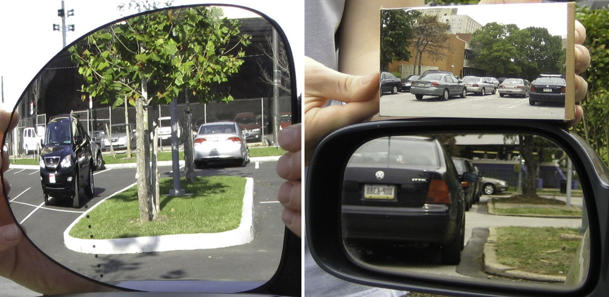Ever since Ray Harroun first bolted a mirror to his car so he could see what was behind
him during the inaugural Indianapolis 500 in 1911, drivers looking back
have had to deal with the blind spot where the mirror couldn't reach.
Many automakers offer cameras and even radar to monitor that spot, but a
new mirror developed by a Drexel University professor could offer a
stunning and safer view without electronics -- and it's closer than it
appears.
The mirrors on the driver's side of every modern car have a field of
view of about 15 to 17 degrees wide -- the angle between two adjacent
numbers on a clock face -- offering a narrow slice of what's going on
behind the car. It's easy enough to make a mirror that curves for a
wider field of view, as passenger-side mirrors do, but that curve
distorts the image, which is why passenger side mirrors always warn
riders that objects are closer than they appear.Blind spots remain one of the larger dangers posed to drivers; a 2008 study by the Insurance Institute for Highway Safety estimated that if all cars were equipped with some kind of blind spot monitoring system, the nation would be spared 457,000 crashes a year. But such systems have only begun to filter down from luxury vehicles, and previous studies have shown it takes up to two decades for a new safety feature to spread through the majority of cars on the road.
Andrew R. Hicks, a mathematics professor at Drexel,
came up with a compromise that doesn't require video cameras. Instead
of bending the mirror like a piece of paper, Hicks says he designed a
surface that acts like thousands of tiny disco balls, whose reflections
are focused by a new algorithm "so that each ray of light bouncing off
the mirror shows the driver a wide, but not-too-distorted, picture of
the scene behind him."
With Hicks' slightly curved mirror, the
driver's field of view expands to 45 degrees wide -- without distorting
the view at its edges.
While Hicks' freshly patented
invention offers a marked improvement over today's mirrors, federal auto
safety laws require strictly flat mirrors for drivers, meaning unless
the law changes Hicks couldn't offer his invention to U.S. automakers as
standard equipment. Regulations in Europe and Asia are not so strict,
and Hicks says some investors have contacted him about producing the
mirror as a replacement, and its benefit could be greater for larger
trucks and buses that often force drivers to rely on two mirrors.
Whatever its future, Hicks has accomplished something rare: Inventing
something that makes an object we use everyday seem so far behind the
times.

No comments:
Post a Comment